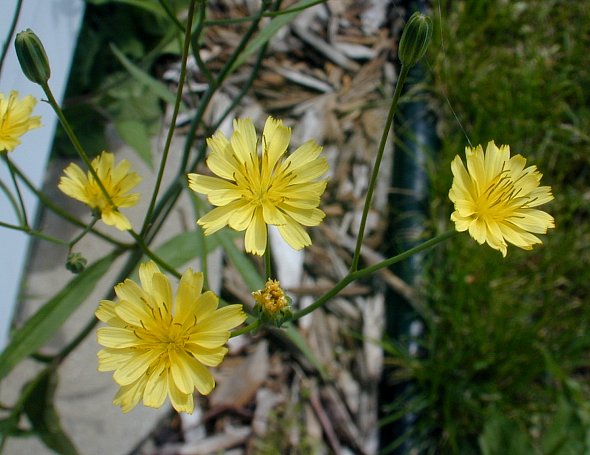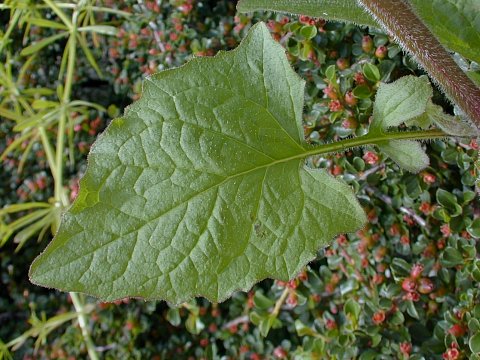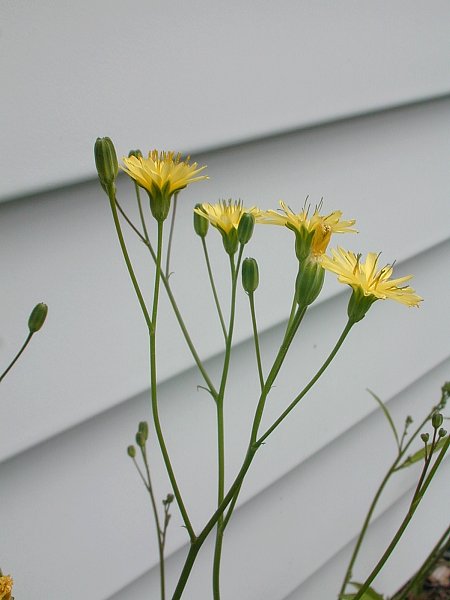Description: This annual or biennial plant is 1–3½' tall; it branches sparingly beneath the inflorescence. The stout central stem is often reddish green, slightly ridged, and covered with white glandular hairs, particularly in the lower part. The alternate lower leaves are up to 6" long and 2½" across. Each of these leaves typically has a large terminal lobe and 2 small side lobes, the latter resembling a pair of elongated 'nipples' at the base of the leaf. The terminal lobe is usually broadly ovate, but shallowly indented or truncate at the base. It has a ciliate margin with widely spaced teeth that are dentate; the margin is also slightly wavy and irregular. The terminal lobe and 2 side lobes are widely separated from each other by a narrow portion of the leaf blade that is only a little broader than the central vein. Below the side lobes, each lower leaf also has a long petiole that is slightly winged and hairy. The upper surface of the leaf blade has a wrinkly appearance where the veins occur and scattered white hairs, while the lower surface has a few scattered hairs along both the primary and secondary veins. The alternate upper leaves are fewer in number and smaller in size as they ascend the central stem; they are usually lanceolate or elliptic, and lack lobes of any kind.

The central stem terminates in a large spreading panicle of composite flowers about ½–1½' long. The round slender stalks of this panicle are hairless. Each composite flower is up to ½" across and consists of about 18-20 spreading ray florets. Each ray floret is pale yellow and truncate at its tip with 5 small teeth. The anthers of the stamens are long and brown with a sagittate base. The base of each composite flower consists of a cylindrical row of 8 green bracts that do not overlap with each other. The blooming period usually occurs from mid-summer to early fall and lasts about 1½–2 months. Each ray floret is replaced by a curved achene that tapers at one end more than the other, and has several fine veins along its length. The achenes are without any tufts of hair. The root system consists of a stout taproot. This plant spreads by reseeding itself.

Cultivation:
Nipplewort usually grows in full sun to light shade, moist to dry
conditions, and soil that is loamy or gravelly. It is an adaptable
plant that can survive infrequent or irregular mowing to produce
flowers during the dry summer months.
Range & Habitat:
The non-native Nipplewort is an uncommon plant that occurs primarily in
NE Illinois .
It is rare or absent elsewhere in the state, although official records
probably underestimate its distribution (see Distribution
Map). Habitats include shady campgrounds, gravelly bars of
rivers, roadsides, city alleys, and edges of yards. This plant prefers
disturbed areas. It is adventive from Eurasia.

Faunal
Associations:
According to Müller of 19th century Germany, the flowers attract mainly
Syrphid flies, especially Eristalis spp. (Drone
Flies), which feed on the pollen. It is possible that small bees visit
the flowers as well. To my knowledge, the foliage is not known to be
toxic, and so it is probably eaten occasionally by mammalian
herbivores, such as rabbits or livestock.
Photographic Location:
The edge of a yard at the apartment complex of the webmaster in Urbana,
Illinois. This species may have been introduced at this location by a
commercial lawn-mowing service or from the mulch that was applied
around the shrubbery. In one close-up photograph, the 'nipples' of one
of the lower leaves are easy to observe.

Comments: Nipplewort is one of many rather weedy members of the Aster family that have been introduced from abroad. Many of these plants have flowerheads with yellow ray florets but no disk florets, of which the most well-known member is Taraxacum officinale (Dandelion). There are also native species with this type of flowerhead, and they are all rather difficult to distinguish from each other. The most distinctive feature of Nipplewort are the two lateral basal lobes on the lower leaves that resemble 'nipples,' hence the common name. Because 'wort' is an old-fashioned word for 'plant,' the common name literally means 'Nipple-Plant.'